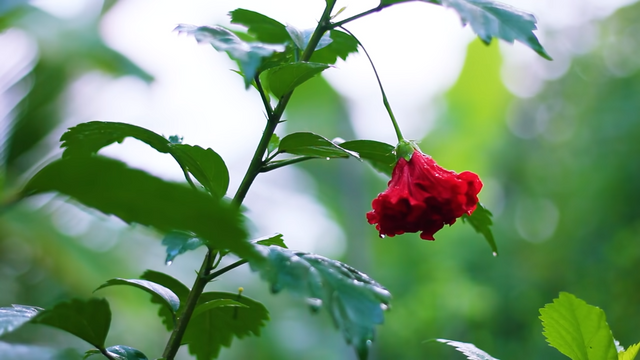Hibiscus rosa-sinensis

Hibiscus rosa-sinensis is a species of tropical hibiscus, a flowering plant in the Hibisceae tribe of the family Malvaceae. It is widely cultivated in tropical and subtropical regions, but is not known in the wild, so that its native distribution is uncertain. An origin in some part of tropical Asia is likely. It is widely grown as an ornamental plant in the tropics and subtropics. The flowers are large, conspicuous, trumpet-shaped, with five petals and their colors can be white to pink, red, orange, peach, and yellow or purple that are 4–18 cm broad. The flowers from various cultivars and hybrids can be either a single flower or a double flower.
At the bottom of every hibiscus bud is the calyx which is green. The pointed ends of the calyx are the sepals. When the hibiscus begins to bloom, the petals begin to grow, which contains multiple petals and multiple colors. The ovary and other female parts of the flower lie in the main structure of the hibiscus, the pistil, which is long and tubular. The hibiscus has both male and female parts on the same flower. The five hairy red spots on the top of the flower is the stigma (female part) of the flower. The stigma is located at the end of the style branch. At the top of the pistil is known as the stigma, where pollen is collected, and in the middle is the style, which is the section that the pollen travels down to the ovary. The ovary lies at the bottom of the blossom and the hibiscus has only one ovary which is superior.
The flowers of Hibiscus rosa-sinensis are edible and are used in salads in the Pacific Islands. The flower is additionally used in hair care as a preparation. It is also used to shine shoes in certain parts of India. It can also be used as a pH indicator. When used, the flower turns acidic solutions to a dark pink or magenta color and basic solutions to green. It is also used for the worship of Devi, and the red variety is especially prominent, having an important part in tantra. In the Bengal area of eastern India, the red variety of this flower is used to worship Kali. In Indonesia, these flowers are called "kembang sepatu", which literally means "shoe flower". In several countries the flowers are dried to use in a beverage, usually tea.
Hibiscus rosa-sinensis is considered to have a number of medical uses in Chinese herbology. Traditional uses in China have been to make a black shoe-polish from its flower petals, or to make a woman's black hair dye. The flowers are also used in parts of China to color various intoxicating liquors.[ The plant may have some potential in cosmetic skin care; for example, an extract from the flowers of Hibiscus rosa-sinensis has been shown to function as an anti-solar agent by absorbing ultraviolet radiation. [Source]
| Device | Xiaomi Redmi Note 4 |
|---|---|
| Category | Nature Photography |
| Location | Sylhet, Bangladesh |
| What3words | https://w3w.co/league.producers.hypnotist |
| Exposure | 1/14 |
| Aperture | 2 |
| Focal Length | 3.6 mm |
| ISO Speed | 800 |
| Flash | Off, Did not fire |
| Photo Credit | © @tanveer741 |